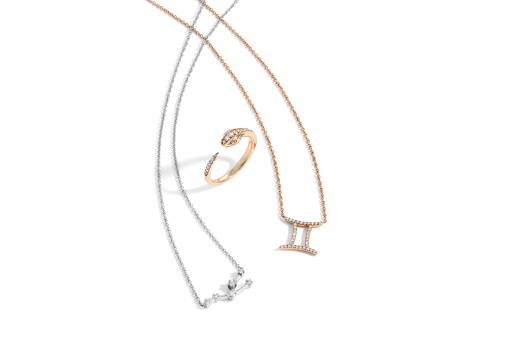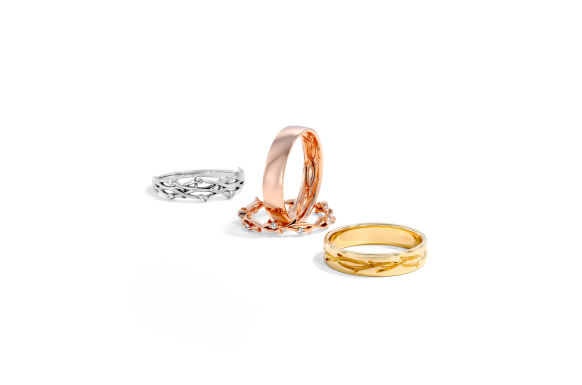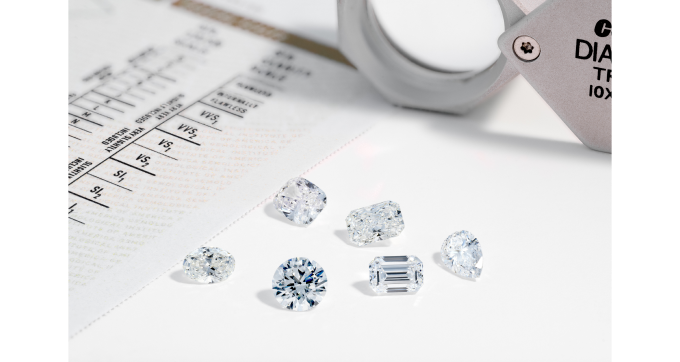Want to snag the biggest diamond for your dollars? Well, obvi. But scoring yourself a bigger stone doesn't always mean you have to rise to the chonkage of a higher carat. Maybe that rock just needs a slight shape up. Real talk, some diamonds just look larger than others. But which one has the most finger coverage? Let's get into shape, shall we?
Going Round In Circles
We all know and love that round brilliant. It’s the most popular diamond shape for engagement rings. It’s also the gold standard in that all other diamonds are usually compared with it.
It’s super easy to see why too. All that brilliant sparkle draws you in. It also doesn’t hurt the visual size. In fact, all that shiny goodness makes the rock pop, so it appears even bigger than it is. The round brilliant truly holds its own in a pack of fancy shape diamonds–that is, anything other than the round herself. Ok, we’ll stop gushing. But now that we know how truly fab it is let’s use it to measure the rest of these rocks.
A Little Sparkle In Your Square
Check it out. How much finger coverage a diamond has, has a lot to do with the depth of the cut. A diamond that carries a lot of weight below the girdle will look smaller than one that holds it in the crown.
Princess cuts, cushions, and Asschers all appear a bit smaller than a round brilliant carat for carat. This is also due in part to their square length-to-width ratio. (Don’t worry, we won’t make you do the math, you can just take our word for it.)
Step cut stones like Asscher's make up for their smaller size with that gorge hall of mirrors effect and stunningly bright flashes of light. That’s all thanks to that depth, we wouldn’t trade it for the world as it’s giving major Hollywood glamour. Princesses and cushions both have a more traditional brilliant sparkle. While we absolutely stan for both of these shiny squares, we’re here for the finger coverage. And these two are not it.
Stretch Out Your Shine
Snagging an elongated stone will get you a little more for your budget. Hello, that’s why we love them! Elongated stones like pears, ovals, and marquise have more surface area, making them appear larger carat for carat. All that brilliant sparkle helps too. See Shapes that have the most finger coverage help you get more for your money because they look bigger than they actually are. On top of that, the average fancy shape diamond costs a bit less than round brilliants. It’s a win-win!
Side By Side Sparkle
The best way to compare the finger coverage of these little gems is to see it for yourself. So let’s look at a few different shapes and see just how they stack up.
Take a look at this lineup, all the stones are the same carat weight, but the sizes look slightly different due to their elongated shape. And while these shapes may also be a bit more narrow, pairing them with a stunning setting featuring a few shoulder or side stones will stretch the silhouette. Also, making these babes unstoppable in the sparkle department.
Perfectly Pear Shaped
Pear-shaped diamonds have oodles of surface area. That gorge elongated teardrop creates super interesting silhouettes. Especially when you pair them with interesting settings like The Mia in rose gold.
All those snatched little stones along the band play off the already bomb brilliant sparkle of the pear. That's not to mention the fierce texture added on by the hidden halo. It’s a stan-worthy combo for sure. Pear-shaped diamonds look bigger carat for carat than a round brilliant, and they cost less too. We live.
The Marvelous Marquise
Somewhere between the pear and the oval is the gorgeous marquise. This long slender diamond looks great on fingers and offers loads of finger coverage. Oh, and did we mention tons of brilliant sparkle? If you’re wondering why you don’t see more marquise engagement rings on the market, it’s because, until recently, they were thought of as more of a right-hand ring.
But once a cocktail party favorite, the marquise is making significant headway into the marriage market. Making these baddies a unique and elegant choice for engagement rings that will definitely turn a few heads.
Simply Oval-Joyed
Ovals are among the most popular picks for those who want a more elongated look. They’re super versatile and look fab in just about any setting you can think of. On top of that, this brilliantly sparkly little gem slimming to the finger and looks bigger carat for carat than a round.
An oval’s visual size can also be majorly enhanced by a few side stones, like the studded sparkle of The Penelope. The added sparkle draws the eye outward, creating the illusion of a larger stone. This trick goes double time for a halo, which can make your center stone look up to a full carat larger. But is it really any surprise? There’s nothing you can’t do with a good oval.
Cushion Collections
You’ve got choices when it comes to the cushion cut. Both have brilliant sparkle and soft curvy corners, but they are way different in the coverage department.
See, the traditional cushion has a more square ratio and tends to be more compact. It has the same flash and flourishes, but it takes up less finger space.
Elongated cushions, on the other hand, tend to take up more finger space. This makes them appear larger carat for carat than their squared-up sister. They're also a bit more slimming to the finger.
Ravishing in a Radiant
Radiant diamonds are known for their crushed ice sparkle. That's all thanks to the oodles of facets they’ve got loaded into that emerald-like shape. The radiant vibe is slightly different from the more traditional brilliant sparkle of all the stones we’ve covered so far. But if you’re a lover of clean lines and significant sparkle, you can't go wrong with a radiant.
Suppose you’re after something a bit out of the box. In that case, the radiant might be the combo of specialized sparkle and coverage you’ve been after.
Emeralds are Everything
Elongated Emeralds offer a different sort of sparkle altogether. Those long straight step-cut facets create a dazzling hall of mirrors effect that just can't be beaten.It’s giving old Hollywood glamour with bright flashes of light and clean, classic lines that bring a sophisticated vibe to any engagement ring.
The Liv doubles down on the whole affair by adding two step-cut stones at the shoulders. It’s truly one of the most clean and classic combos, and it’s definitely a house fav.
Swayed by the Settings
Shapes aside, some settings can increase the finger coverage of any diamond. While a solitaire lets the center stone be the star of the show, it doesn’t add to the finger coverage. Pavé settings have a magical way of expanding the visual size of a diamond by extending the sparkle around the ring.
When it comes to getting the most bang for your buck, nothing comes close to a halo. Halos do the absolute most for the visual size of any diamond. They can actually make the stone look up to a full carat larger. Look at this Michelle with a 2ct oval and tell us it’s not giving the absolute most. Still, this is a slimmer example. The bigger the stones around the halo, the bigger your center stone will appear.
Finna' Pick Your Fav?
We love a little extra dazzle, and that little boost in the visual department makes a high-key difference. For the love of finger coverage, we stan for round, ovals, and pears with a bit of elongated cushion action sprinkled in for good measure.
Choosing a diamond with more finger coverage means more bang for your buck and a larger look carat for carat. Not to mention a little more room for sparkle, and who doesn't love that?






